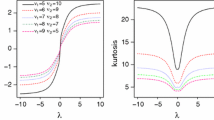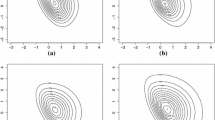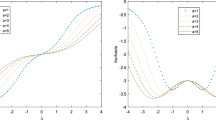Abstract
Finite mixtures of multivariate skew distributions have become increasingly popular in recent years due to their flexibility and robustness in modeling heterogeneity, asymmetry and leptokurticness of the data. This paper introduces a novel finite mixture of multivariate scale-shape mixtures of skew-normal distributions to enhance strength and flexibility when modeling heterogeneous multivariate data that contain more extreme non-normal features. A computational tractable ECM algorithm which consists of analytically simple E- and CM-steps is developed to carry out maximum likelihood estimation of parameters. The asymptotic covariance matrix of parameter estimates is derived from the observed information matrix using the outer product of expected complete-data scores. We demonstrate the utility of the proposed approach through simulated and real data examples.




Similar content being viewed by others
References
Aghaeepour N, Finak G, Hoos H, Osmann T, Gottardo R, Brinkman RR, Scheuermann RH, The Flowcap Consortium, The Dream Consortium (2013) Critical assessment of automated flow cytometryanalysis techniques. Nat Methods 10:228–238
Aitken AC (1926) On Bernoulli’s numerical solution of algebraic equations. Proc R Soc Edinb 46:289–305
Arellano-Valle RB, Bolfarine H, Lachos VH (2005) Skew-normal linear mixed models. J Data Sci 3:415–438
Arellano-Valle RB, Ferreira CS, Genton M (2018) Scale and shape mixtures of multivariate skew-normal distributions. J Multivar Anal 166:98–110
Arellano-Valle RB, Genton M (2005) On fundamental skew distributions. J Multivar Anal 96:93–116
Azzalini A, Dalla Valle A (1996) The multivariate skew-normal distribution. Biometrika 83:715–726
Azzalini A, Capitaino A (2003) Distributions generated by perturbation of symmetry with emphasis on a multivariate skew $t$-distribution. J R Stat Soc B 65:367–389
Barndorff-Nielsen OE, Biaesild P (1981) Hyperbolic distributions and ramifications: contributions to theory and applications. In: Taillie C, Patil GP, Baldessari BA (eds) Statistical distributions in scientific work, vol 4. D. Reidel, Amsterdam, pp 19–44
Barndorff-Nielsen OE, Stelzer R (2005) Absolute moments of generalized hyperbolic distributions and approximate scaling of normal inverse Gaussian Lévy processes. Scand J Stat 32(4):617–637
Basford KE, Greenway DR, Mclachlan GJ, Peel D (1997) Standard errors of fitted means under normal mixture. Comput Stat 12:1–17
Branco MD, Dey DK (2001) A general class of multivariate skew-elliptical distributions. J Multivar Anal 79:99–113
Cabral C, Lachos V, Prates M (2012) Multivariate mixture modeling using skew-normal independent distributions. Comput Stat Data Anal 56:126–142
Cramér H (1946) Mathematical methods of statistics. Princeton University Press, Princeton
Dempster AP, Laird NM, Rubin DB (1977) Maximum likelihood from incomplete data via the EM algorithm (with discussion). J R Stat Soc B 39:1–38
Ferreira CS, Lachos VH, Bolfarine H (2016) Likelihood-based inference for multivariate skew scale mixtures of normal distributions. AStA Adv Stat Anal 100:421–441
Good IJ (1953) The population frequencies of species and the estimation of population parameters. Biometrika 40:237–260
Jamalizadeh A, Lin TI (2017) A general class of scale-shape mixtures of skew-normal distributions: properties and estimation. Comput Stat 32:451–474
Jørgensen S (1982) Statistical properties of the generalized inverse Gaussian distribution. Springer, New York
Kozubowski TJ, Podgórski K (2000) A multivariate and asymmetric generalization of Laplace distribution. Comput Stat 15:531–540
Lachos VH, Moreno EL, Kun C, Barbosa-Cabral CR (2017) Finite mixture modeling of censored data using the multivariate student-$t$ distribution. J Multivar Anal 159:151–167
Lee SX, McLachlan GJ (2016) Finite mixtures of canonical fundamental skew $t$-distributions. Stat Comput 26:573–589
Lee SX, McLachlan GJ (2013) EMMIXuskew: an R package for fitting mixtures of multivariate skew $t$-distributions via the EM algorithm. J Stat Softw 55:1–22
Lin TI (2009) Maximum likelihood estimation for multivariate skew normal mixture models. J Multivar Anal 100:257–265
Lin TI (2010) Robust mixture modeling using multivariate skew $t$ distributions. Stat Comput 20:343–356
Lin TI (2014) Learning from incomplete data via parameterized $t$ mixture models through eigenvalue decomposition. Comput Stat Data Anal 71:183–195
Lin TI, Ho HJ, Lee CR (2014) Flexible mixture modelling using the multivariate skew-$t$-normal distribution. Stat Comput 24:531–546
Liu CH, Rubin DB (1994) The ECME algorithm: a simple extension of EM and ECM with faster monotone convergence. Biometrika 81:633–648
Louis TA (1982) Finding the observed information matrix when using the EM algorithm. J R Stat Soc B 44:226–233
McNicholas PD, Murphy TB, Mcdaid AF, Frost D (2010) Serial and parallel implementations of model-based clustering via parsimonious Gaussian mixture models. Comput Stat Data Anal 54:711–723
Meng XL, Rubin DB (1993) Maximum likelihood estimation via the ECM algorithm: a general framework. Biometrika 80:267–278
Meng XL, van Dyk D (1997) The EM algorithm-an old folk-song sung to a fast new tune. J R Stat Soc B 59:511–556
Pyne S, Hu X, Wang K, Rossin E, Lin TI, Maier LM, Baecher-Allan C, Mclachlan GJ, Tamayo P, Hafler DA, De Jager PL, Mesirov JP (2009) Automated high-dimensional flow cytometric data analysis. Proc Natl Acad Sci USA 106:8519–8524
Robert CP, Casella G (2004) Monte Carlo statistical methods, 2nd edn. Springer, New York
Schwarz G (1978) Estimating the dimension of a model. Ann Stat 6:461–464
Wang J, Genton MG (2006) The multivariate skew-slash distribution. J Stat Plan Inf 136:209–220
Acknowledgements
We thank the editor, associate editor, and two referees for their valuable comments and suggestions on the earlier version of this paper. We are also grateful to Mr. Chien-Jung Chiang for his assistance in initial simulations. This research was supported by the Ministry of Science and Technology of Taiwan under Grant Nos. 107-2628-M-035-001-MY3 and 107-2118-M-005-002-MY2.
Author information
Authors and Affiliations
Corresponding author
Electronic supplementary material
Below is the link to the electronic supplementary material.
Appendices
Appendix A: Family of MSSMSN distributions
1.1 General formulation
Let \(U_{1}\) be a N(0, 1) random variable and assumed to be independent of \({\varvec{U}}_{2}\), a p-dimensional random vector following a \(N_{p}({\varvec{0}},{\varvec{I}}_{p})\) distribution. Let \(\tau _{1}\) and \(\tau _{2}\) be two independent positive random variables with a joint pdf \(h(\tau _{1},\tau _{2};{\varvec{\nu }})\), where \({\varvec{\nu }}\) is a vector of parameters controlling the thickness of the tails. Further, we assume that \({\varvec{U}}=(U_{1},{\varvec{U}}_{2})\) and \({\varvec{\tau }}=(\tau _{1},\tau _{2})\) are independent. Let \({\varvec{Y}}\) be a random vector satisfying the specification of (4). We shall say that \({\varvec{Y}}\) follows a MSSMSN distribution, denoted by \({\varvec{Y}}\sim SSMSN_p({\varvec{\xi }},{\varvec{\varSigma }},{\varvec{\lambda }},{\varvec{\nu }})\). A stochastic representation of the MSSMSN distribution is given by
where \(f=\tau _{1}/\tau _{2}\).
Let \(\gamma =\tau _{1}^{-1/2}(f+{\varvec{\lambda }}^{\top }{\varvec{\lambda }})^{1/2}|U_{1}|\) be a reparameterized latent variable. Alternatively, the MSSMSN distribution has a three-level hierarchical representation:
where \(TN(\mu ,\sigma ^2; (a, b))\) represents the truncated normal distribution for \(N(\mu ,\sigma ^2)\) whose support is bounded between interval (a, b). Combining all pdfs in (A.2), the joint pdf of \({\varvec{Y}}\), \(\gamma \), \(\tau _{1}\) and \(\tau _{2}\) is
where \(\Delta =\sqrt{({\varvec{y}}-{\varvec{\xi }})^{\top }{\varvec{\varSigma }}^{-1}({\varvec{y}}-{\varvec{\xi }})}\) and \(\eta ={\varvec{\lambda }}^{\top }{\varvec{\varSigma }}^{-1/2}({\varvec{y}}-{\varvec{\xi }})\). Integrating out \(\gamma \) in (A.3), we obtain
where \(\phi (\cdot )\) denotes the pdf of N(0, 1). Subsequently, the marginal pdf of \({\varvec{Y}}\) is obtained as
More details about members of the MSSMSN family are discussed later.
Dividing (A.3) by (A.4), we find that \(\gamma \) and \(\tau _{1}\) are conditionally independent given \({\varvec{Y}}={\varvec{y}}\), i.e., \(f(\gamma \mid {\varvec{y}},\tau _{1},\tau _{2})=f(\gamma \mid {\varvec{y}},\tau _{2})\), and thereby
Moreover, dividing (A.4) by (A.5) gives
Making use of the first two moments of MSN distribution and applying the law of iterated expectations, the mean vector and covariance matrix of \({\varvec{Y}}\) are given by
where \(\zeta _0=E(\tau ^{-1}_{1})\) and \(\zeta _1=E(\tau _{1}^{-1/2}(f+{\varvec{\lambda }}^{\top }{\varvec{\lambda }})^{-1/2})\), which can be exactly evaluated by numerical integration methods.
1.2 Multivariate skew-t-t distribution
Consider two independent random variables \(\tau _{1}\sim \varGamma (\nu _{1}/2,\nu _{2}/2)\) and \(\tau _{2}\sim \varGamma (\nu _{2}/2,\nu _{2}/2)\) with the joint pdf given by
where \({\varvec{\nu }}=(\nu _{1},\nu _{2})\) and \(g(\cdot \mid \alpha ,\beta )\) stands for the pdf of a gamma distribution with mean \(\alpha /\beta \). In this setting, we can derive the multivariate skew-t-t (MSTT) distribution, denoted by \({\varvec{Y}}\sim STT_p({\varvec{\xi }},{\varvec{\varSigma }},{\varvec{\lambda }},\nu _{1},\nu _{2})\), with pdf
Remark that, when \(\nu _1\) and \(\nu _2\) are restricted to be equal, the MSTT density is very close to the MST density of (3), showing virtually indistinguishable performance of density estimation. The issue is examined numerically by a simulation study in Sect. 4.1.
A comparison of MSN and MSTT contours by plotting \(f_{MSTT}({\varvec{y}};{\varvec{\xi }},{\varvec{\varSigma }},{\varvec{\lambda }},\nu _1,\nu _2)=c\) for \(c=0.1\) and 0.01, where \({\varvec{\xi }}=(0,0)^{\top },{\varvec{\varSigma }}={\varvec{I}}_{2}\), \({\varvec{\lambda }}=(3,3)^{\top }\), \(\nu _{1}=4\) and various choices of \(\nu _2\)
If follows from (A.7) that \(\tau _{1}\mid ({\varvec{Y}}={\varvec{y}})\sim \varGamma \left( (\nu _{1}+p)/2,(\nu _{1}+\Delta ^2)/2\right) \). Moreover, the conditional pdf of \(\tau _{2}\) given \({\varvec{Y}}={\varvec{y}}\) is
As a result, we have the following conditional expectations:
where \(a_{\nu }=\varGamma ((\nu -1)/2)/\varGamma (\nu /2)\) and \(\mathrm{DG}(x)=d\log \varGamma (x)/dx\) is the digamma function.
Figure 5 displays the contour plots of bivariate densities given in (A.8), obtained with the solutions of \(f_{MSTT}({\varvec{y}};{\varvec{\xi }},{\varvec{\varSigma }},{\varvec{\lambda }},\nu _{1},\nu _{2}) = c\), for \(c=0.1\) and 0.01, where \({\varvec{\xi }}=(0,0)^{\top },{\varvec{\varSigma }}={\varvec{I}}_{2}\), \({\varvec{\lambda }}=(3,3)^{\top }\), \(\nu _{1}=4\) and various choices of \(\nu _{2}\). The MSN contours obtained by setting \(\nu _1=\nu _2=\infty \) are also shown for the sake of comparison. Apparently, the MSN contour lies mostly outside the MSTT contours for \(c=0.1\), while an opposite phenomenon happens for \(c=0.01\). Note that the MSTT distribution contains two DOF parameters in which \(\nu _1\) controls the main body kurtosis, while the \(\nu _2\) is used to add flexibility in turning the extra kurtosis. As remarked previously, the contours drawn at \(\nu _1=\nu _2=4\) correspond to a near of MST setting. It can be observed from Fig. 5(b) that a smaller value of \(\nu _2\) enables a wider range of contour area, indicating that the MSST distribution is more flexible and should provide more robustness against extreme outliers than the MSN and MST distributions.
One thing worth noting is that the MSTT distribution includes the MSN, multivariate skew-t-normal (MSTN) and multivariate skew-normal-t (MSNT) distributions as particular members. The MSTN distribution is formulated by taking \(\nu _1=\nu \) and \(\nu _2=\infty \) with the pdf \(f_{MSTN}({\varvec{y}};{\varvec{\xi }},{\varvec{\varSigma }},{\varvec{\lambda }},\nu )=2t_{p}({\varvec{y}};{\varvec{\xi }},{\varvec{\varSigma }},\nu )\varPhi (\eta )\). More essential properties concerning the MSTN distribution can be found in Lin et al. (2014). In contrast, the MSNT distribution is obtained by letting \(\nu _1=\infty \) and \(\nu _2=\nu \) with the pdf taking the form of \(f_{MSNT}({\varvec{y}};{\varvec{\xi }},{\varvec{\varSigma }},{\varvec{\lambda }},\nu )=2\phi _{p}({\varvec{y}};{\varvec{\xi }},{\varvec{\varSigma }})T(\eta ;\nu )\). Notably, the Fisher information of the shape and DOF parameters \(({\varvec{\lambda }},\nu )\) is zero for both MSTN and MSNT distributions, indicating that their ML estimates are asymptotically uncorrelated. However, this is not the case for the MST distribution as considered by Azzalini and Capitaino (2003) and Pyne et al. (2009).
1.3 Multivariate skew generalized Laplace normal distribution
The multivariate generalized Laplace (MGL) distribution, as proposed by Kozubowski and Podgórski (2000), has the pdf:
where \(K_{r}(a)\) denotes the modified Bessel function of the third kind of order \(r\in \mathbb {R}\), also known as the MacDonald function, defined as
One important feature of \(K_{r}(x)\) is symmetric with respect to r, namely \(K_{r}(x)=K_{-r}(x)\). When \(r=\pm 1/2\), it can be written in a simpler form of \(K_{\pm 1/2}(x)=\sqrt{\pi /2}x^{-1/2}e^{-x}\). Moreover, the derivative of (A.10) with respect to r is
For more properties and relations about the Bessel functions, one can refer to Barndorff-Nielsen and Biaesild (1981).
If we choose \(\tau _{1}\sim \varGamma ^{-1}(\alpha ,1/2)\) and \(\tau _{2}=1\) in (A.1), where \(\varGamma ^{-1}(\alpha ,1/2)\) denotes the inverse gamma distribution with shape \(\alpha \) and scale 1 / 2, it leads to a multivariate skew generalized Laplace normal (MSGLN) distribution, denoted by \({\varvec{Y}}\sim SGLN_p({\varvec{\xi }},{\varvec{\varSigma }},{\varvec{\lambda }},\alpha )\). From (A.5), the pdf of \({\varvec{Y}}\) is
A random variable X has the Generalized Inverse Gaussian (GIG) distribution (Good 1953) with parameters \(\chi ,\psi \in \mathbb {R}^{+}\) and \(\nu \in \mathbb {R}\), denoted by \(X\sim GIG(q,\chi ,\psi )\), if it has the pdf:
where \(\chi \) and \(\psi \) regulate both the concentration and scaling of the density, while q bears no concrete statistical meaning. The possible domains for the three parameters are (i) \(\chi \ge 0,\psi >0\) if \(q>0\); (ii) \(\psi \ge 0,\chi >0\) if \(q<0\); (iii) \(\chi>0,\psi >0\) if \(q=0\). The GIG distribution includes several special cases such as the inverse Gaussian if \(q=-1/2\), the hyperbolic if \(q=0\), the gamma distributions if \(q=0,\chi =0\), and so on. More information about the GIG distribution and related statistical applications can be found in Jørgensen (1982) and Barndorff-Nielsen and Stelzer (2005) and the references therein.
Substituting \(\tau _2=1\) into (A.6) and (A.7) results in \(\gamma \mid ({\varvec{y}},\tau _{2})\sim TN(\eta ,1;(0,\infty ))\) and \(\tau \mid ({\varvec{Y}}={\varvec{y}})\sim GIG(p/2-\alpha ,1,\Delta ^2)\). It is easy to see hat \(\tau \) and \(\gamma \) are independent conditional on \({\varvec{Y}}={\varvec{y}}\). In our developed EM-based algorithm, we need to exploit the following conditional expectations:
and
where \(K_{p/2-\alpha }^{'}(\Delta )\) is evaluated via (A.11).
Multivariate skew-slash-normal distribution
According to Wang and Genton (2006), the multivariate slash (MS) distribution can be stochastically represented by \({\varvec{Y}}={\varvec{\xi }}+{\varvec{\varSigma }}^{1/2}{\varvec{Z}} U^{-1/q}\), where \({\varvec{Z}}\sim N_{p}({\varvec{0}},{\varvec{I}}_{p})\) is independent of U, which is a uniform random variable on (0,1). The pdf of \({\varvec{Y}}\) is
where \(G(a;\alpha )=\int _{0}^a x^{\alpha -1}e^{-x\alpha }dx\) is the incomplete gamma function, and q is a tuning parameter controlling the thickness of tails. When \(q\rightarrow \infty \), \({\varvec{Y}}\) approaches a \(N_p({\varvec{\xi }},{\varvec{\varSigma }})\) distribution, indicating that the MS distribution has heavier tails than the MN distribution when q tends to be small.
Through setting \(\tau _{1}\sim Beta(q/2,1)\) and \(\tau _{2}=1\) in (A.1), we can generate a multivariate skew-slash-normal (MSSN) distribution. Using the result in (A.5), we obtain the MSSN density:
and write \({\varvec{Y}}\sim SSN_p({\varvec{\xi }},{\varvec{\varSigma }},{\varvec{\lambda }},q)\) for short. Therefore, the MSSN distribution increases the flexibility of the MS distribution with an additional parameter vector \({\varvec{\lambda }}\) governing the shape of the distribution. It is worth noting that (A.14) is not identical to (9) of Wang and Genton (2006) obtained by setting \(\tau _1=\tau _2=\tau \), where \(\tau \sim Beta(q/2,1)\).
It follows from (A.7) that the conditional pdf of \(\tau \) given \({{\varvec{Y}}}={{\varvec{y}}}\) is
Accordingly, we obtain
and
Formulae (A.15) and (A.16) are used when performing the EM-based algorithm. Besides, working the same with the MSGN distribution, we obtain \(\gamma \mid ({\varvec{Y}}={\varvec{y}})\sim TN(\eta ,1;(0,\infty ))\) because of the independence between \(\tau \) and \(\gamma \) conditioning on \({\varvec{Y}}={\varvec{y}}\).
Appendix B: Detailed proof of partial derivatives in (15)
The partial derivatives of \(\ell _{cj}=\ell _{cj}({\varvec{\varTheta }}\mid {\varvec{y}}_{j},{\varvec{\gamma }}_{j},{\varvec{\tau }}_{1j},{\varvec{\tau }}_{2j},{\varvec{Z}}_{j})\) defined in (14) with respect to each entry of parameters are given as follows:
Besides, the partial derivatives of (14) with respect to \({\varvec{\nu }}_i\) are discussed as follows:
- Case 1::
-
For the FM-MSTT model, we have
$$\begin{aligned} \frac{\partial \ell _{cj}}{\partial \nu _{1i}}= & {} \frac{Z_{ij}}{2}\left[ \log \left( \frac{\nu _{1i}}{2}\right) +1+\log \tau _{1j}-\tau _{1j}-\mathrm{DG}\left( \frac{\nu _{1i}}{2}\right) \right] , \end{aligned}$$and
$$\begin{aligned} \frac{\partial \ell _{cj}}{\partial \nu _{2i}}= & {} \frac{Z_{ij}}{2}\left[ \log \left( \frac{\nu _{2i}}{2}\right) +1+\log \tau _{2j}-\tau _{2j}-\mathrm{DG}\left( \frac{\nu _{2i}}{2}\right) \right] . \end{aligned}$$ - Case 2::
-
For the FM-MSGLN model, we have
$$\begin{aligned} \frac{\partial \ell _{cj}}{\partial \alpha _{i}}= & {} Z_{ij}\left( -\log 2-\mathrm{DG}(\alpha _{i})-\log \tau _{j}\right) . \end{aligned}$$ - Case 3::
-
For the FM-MSSN model, we have
$$\begin{aligned} \frac{\partial \ell _{cj}}{\partial q_{i}}= & {} Z_{ij}\left( \frac{1}{q_{i}}+\frac{1}{2}\log \tau _{j}\right) . \end{aligned}$$
Given the ML estimate \(\hat{{\varvec{\varTheta }}}\), the gradients given in (15) can be obtained straightforwardly by taking the expectations of the above derivatives with respect to the conditional distribution of \(({\varvec{\gamma }}_{j},{\varvec{\tau }}_{1j},{\varvec{\tau }}_{2j},{\varvec{Z}}_{j})\) given \({\varvec{Y}}_j={\varvec{y}}_j\). \(\square \)
Rights and permissions
About this article
Cite this article
Wang, WL., Jamalizadeh, A. & Lin, TI. Finite mixtures of multivariate scale-shape mixtures of skew-normal distributions. Stat Papers 61, 2643–2670 (2020). https://doi.org/10.1007/s00362-018-01061-z
Received:
Revised:
Published:
Issue Date:
DOI: https://doi.org/10.1007/s00362-018-01061-z





